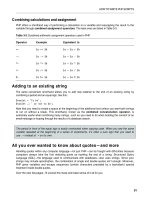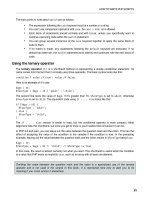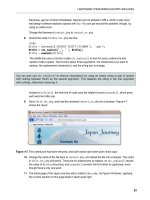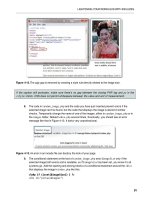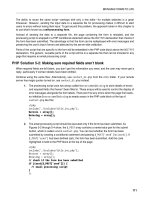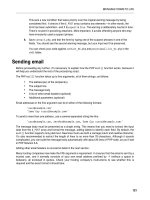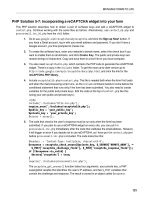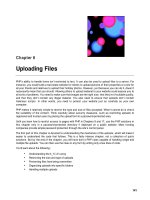Giải pháp thiết kế web động với PHP - p 9 pdf
Bạn đang xem bản rút gọn của tài liệu. Xem và tải ngay bản đầy đủ của tài liệu tại đây (635.27 KB, 10 trang )
HOW TO WRITE PHP SCRIPTS
61
The main points to note about switch are as follows:
• The expression following the case keyword must be a number or a string.
• You cant use comparison operators with case. So case > 100: isnt allowed.
• Each block of statements should normally end with break, unless you specifically want to
continue executing code within the switch statement.
• You can group several instances of the case keyword together to apply the same block of
code to them.
• If no match is made, any statements following the default keyword are executed. If no
default has been set, the switch statement exits silently and continues with the next block of
code.
Using the ternary operator
The ternary operator (?:) is a shorthand method of representing a simple conditional statement. Its
name comes from the fact that it normally uses three operands. The basic syntax looks like this:
condition
?
value if true
:
value if false
;
Here is an example of it in use:
$age = 17;
$fareType = $age > 16 ? 'adult' : 'child';
The second line tests the value of $age. If its greater than 16, $fareType is set to adult, otherwise
$fareType is set to child. The equivalent code using if . . . else looks like this:
if ($age > 16) {
$fareType = 'adult';
} else {
$fareType = 'child';
}
The if . . . else version is easier to read, but the conditional operator is more compact. Most
beginners hate this shorthand, but once you get to know it, youll realize how convenient it can be.
In PHP 5.3 and later, you can leave out the value between the question mark and the colon. This has the
effect of assigning the value of the condition to the variable if the condition is true. In the preceding
example, leaving out the value between the question mark and the colon results in $fareType being true:
$age = 17;
$fareType = $age > 16 ?: 'child'; // $fareType is true
In this case, the result is almost certainly not what you want. This shorthand is useful when the condition
is a value that PHP treats as implicitly true, such as an array with at least one element.
Omitting the value between the question mark and the colon is a specialized use of the ternary
operator and is not used in the scripts in this book. It is mentioned here only to alert you to its
meaning if you come across it elsewhere.
CHAPTER 3
62
Creating loops
A loop is a section of code that is repeated over and over again until a certain condition is met. Loops are
often controlled by setting a variable to count the number of iterations. By increasing the variable by one
each time, the loop comes to a halt when the variable gets to a preset number. The other way loops are
controlled is by running through each item of an array. When there are no more items to process, the loop
stops.
Loops frequently contain conditional statements, so although theyre very simple in structure, they can be
used to create code that processes data in often sophisticated ways.
Loops using while and do . . . while
The simplest type of loop is called a while loop. Its basic structure looks like this:
while (
condition is true
) {
do something
}
The following code displays every number from 1 through 100 in a browser (you can test it in while.php in
the files for this chapter). It begins by setting a variable ($i) to 1 and then using the variable as a counter
to control the loop, as well as display the current number onscreen.
$i = 1; // set counter
while ($i <= 100) {
echo "$i<br>";
$i++; // increase counter by 1
}
In the first half of this chapter, I warned against using variables with cryptic names. However, using
$i
as a counter is widely accepted convention. If
$i
is already in use, the normal practice is to use
$j
or
$k
as counters.
A variation of the while loop uses the keyword do and follows this basic pattern:
do {
code to be executed
} while (
condition to be tested
);
The difference between a do . . . while loop and a while loop is that the code within the do block is
executed at least once, even if the condition is never true. The following code (in dowhile.php) displays
the value of $i once, even though its greater than the maximum expected.
$i = 1000;
do {
echo "$i<br>";
$i++; // increase counter by 1
} while ($i <= 100);
Download from Wow! eBook <www.wowebook.com>
HOW TO WRITE PHP SCRIPTS
63
The danger with while and do . . . while loops is forgetting to set a condition that brings the loop to
an end or setting an impossible condition. When this happens, you create an infinite loop that either
freezes your computer or causes the browser to crash.
The versatile for loop
The for loop is less prone to generating an infinite loop because you are required to declare all the
conditions of the loop in the first line. The for loop uses the following basic pattern:
for (
initialize loop
;
condition
;
code to run after each iteration
) {
code to be executed
}
The following code does exactly the same as the previous while loop, displaying every number from 1 to
100 (see forloop.php):
for ($i = 1; $i <= 100; $i++) {
echo "$i<br>";
}
The three expressions inside the parentheses control the action of the loop (note that they are separated
by semicolons, not commas):
• The first expression is executed before the loop starts. In this case, it sets the initial value of
the counter variable $i to 1.
• The second expression sets the condition that determines how long the loop should continue
to run. This can be a fixed number, a variable, or an expression that calculates a value.
• The third expression is executed at the end of each iteration of the loop. In this case, it
increases $i by 1, but there is nothing stopping you from using bigger steps. For instance,
replacing $i++ with $i+=10 in this example would display 1, 11, 21, 31, and so on.
Looping through arrays with foreach
The final type of loop in PHP is used exclusively with arrays. It takes two forms, both of which use
temporary variables to handle each array element. If you only need to do something with the value of each
array element, the foreach loop takes the following form:
foreach (
array_name
as
temporary_variable
) {
do something with temporary_variable
}
The following example loops through the $shoppingList array and displays the name of each item (the
code is in shopping_list.php):
$shoppingList = array('wine', 'fish', 'bread', 'grapes', 'cheese');
foreach ($shoppingList as $item) {
echo $item . '<br>';
}
Although the preceding example uses an indexed array, you can also use the simple form of the foreach
loop with an associative array. However, the alternative form of the foreach loop is of more use with
CHAPTER 3
64
associative arrays, because it gives access to both the key and value of each array element. It takes this
slightly different form:
foreach (
array_name
as
key_variable
=>
value_variable
) {
do something with key_variable and value_variable
}
This next example uses the $book associative array from the “Creating arrays” section earlier in the
chapter and incorporates the key and value of each element into a simple string, as shown in the
screenshot (see book.php):
foreach ($book as $key => $value) {
echo "The value of $key is $value<br>";
}
The
foreach
keyword is one word. Inserting a space between
for
and
each
doesnt work.
Breaking out of a loop
To bring a loop prematurely to an end when a certain condition is met, insert the break keyword inside a
conditional statement. As soon as the script encounters break, it exits the loop.
To skip an iteration of the loop when a certain condition is met, use the continue keyword. Instead of
exiting, it returns to the top of the loop and executes the next iteration. For example, the following loop
skips the current element if $photo has no value:
foreach ($photos as $photo) {
if (empty($photo)) continue;
// code to display a photo
}
Modularizing code with functions
Functions offer a convenient way of running frequently performed operations. In addition to the large
number of built-in functions, PHP lets you create your own. The advantages are that you write the code
only once, rather than needing to retype it everywhere you need it. This not only speeds up your
development time but also makes your code easier to read and maintain. If theres a problem with the code
in your function, you update it in just one place rather than hunting through your entire site. Moreover,
functions usually speed up the processing of your pages.
HOW TO WRITE PHP SCRIPTS
65
Building your own functions in PHP is very easy. You simply wrap a block of code in a pair of curly braces
and use the function keyword to name your new function. The function name is always followed by a pair
of parentheses. The following—admittedly trivial—example demonstrates the basic structure of a custom-
built function (see functions1.php in the files for this chapter):
function sayHi() {
echo 'Hi!';
}
Simply putting sayHi(); in a PHP code block results in Hi! being displayed onscreen. This type of
function is like a drone: it always performs exactly the same operation. For functions to be responsive to
circumstances, you need to pass values to them as arguments (or parameters).
Passing values to functions
Lets say you want to adapt the sayHi() function so that it displays someones name. You do this by
inserting a variable between the parentheses in the function declaration. The same variable is then used
inside the function to display whatever value is passed to the function. To pass more than one argument
to a function, separate the variables with commas inside the opening parentheses. This is how the revised
function looks (see functions2.php):
function sayHi($name) {
echo "Hi, $name!";
}
You can now use this function inside a page to display the value of any variable passed to sayHi(). For
instance, if you have an online form that saves someones name in a variable called $visitor, and Ben
visits your site, you give him the sort of personal greeting shown alongside by putting sayHi($visitor);
in your page.
A downside of PHPs weak typing is that if Ben is being particularly uncooperative, he might type 5 into the
form instead of his name, giving you not quite the type of high five you might have been expecting.
This illustrates why its so important to check user input before using it in any critical situation.
Its also important to understand that variables inside a function remain exclusive to the function. This
example should illustrate the point (see functions3.php):
function doubleIt($number) {
$number *= 2;
echo "$number<br>";
}
$number = 4;
doubleIt($number);
echo $number;
CHAPTER 3
66
If you view the output of this code in a browser, you may get a very different result from what you expect.
The function takes a number, doubles it, and displays it onscreen. Line 5 of the script assigns the value 4
to $number. The next line calls the function and passes it $number as an argument. The function
processes $number and displays 8. After the function comes to an end, $number is displayed onscreen
by echo. This time, it will be 4 and not 8.
This example demonstrates that the variable $number that has been declared inside the function is limited
in scope to the function itself. The variable called $number in the main script is totally unrelated to the one
inside the function. To avoid confusion, its a good idea to use variable names in the rest of your script
that are different from those used inside functions. This isnt always possible, so its useful to know that
functions work like little black boxes and dont normally have any direct impact on the values of variables
in the rest of the script.
Returning values from functions
Theres more than one way to get a function to change the value of a variable passed to it as an argument,
but the most important method is to use the return keyword and to assign the result either to the same
variable or to another one. This can be demonstrated by amending the doubleIt() function like this:
function doubleIt($number) {
return $number *= 2;
}
$num = 4;
$doubled = doubleIt($num);
echo "\$num is: $num<br>";
echo "\$doubled is: $doubled";
You can test this code in functions4.php. The result is shown in the screenshot following the code. This
time, I have used different names for the variables to avoid confusing them. I have also assigned the
result of doubleIt($num) to a new variable. The benefit of doing this is that I now have available both the
original value and the result of the calculation. You wont always want to keep the original value, but it can
be very useful at times.
Where to locate custom-built functions
If your custom-built function is in the same page as its being used, it doesnt matter where you declare the
function; it can be either before or after its used. Its a good idea, however, to store functions together,
either at the top or the bottom of a page. This makes them easier to find and maintain.
Functions that are used in more than one page are best stored in an external file and included in each
page. Including external files with include() and require() is covered in detail in Chapter 4. When
functions are stored in external files, you must include the external file before calling any of its functions.
HOW TO WRITE PHP SCRIPTS
67
PHP quick checklist
This chapter contains a lot of information that is impossible to absorb in one sitting, but hopefully the first
half has given you a broad overview of how PHP works. Heres a reminder of some of the main points:
• Always give PHP pages the correct filename extension, normally .php.
• Enclose all PHP code between the correct tags: <?php and ?>.
• Avoid the short form of the opening tag: <?. Using <?php is more reliable.
• Its recommended to omit the closing PHP tag in files that contain only PHP code.
• PHP variables begin with $ followed by a letter or the underscore character.
• Choose meaningful variable names, and remember theyre case-sensitive.
• Use comments to remind you what your script does.
• Remember that numbers dont require quotes, but strings (text) do.
• You can use single or double quotes, but the outer pair must match.
• Use a backslash to escape quotes of the same type inside a string.
• To store related items together, use an array.
• Use conditional statements, such as if and if . . . else, for decision-making.
• Simplify repetitive tasks with loops.
• Use functions to perform preset tasks.
• Display PHP output with echo or print.
• Inspect the content of arrays with print_r().
• With most error messages, work backwa rd from the position indicated.
• Keep smiling—and remember that PHP is not difficult.
CHAPTER 3
68
69
Chapter 4
Lightening Your Workload with Includes
The ability to include the contents of one file inside another is one of the most powerful features of PHP.
Its also one of the easiest to implement.
Most pages in a website share common elements, such as a header, footer, and navigation menu. You
can alter the look of those elements throughout the site by changing the style rules in an external style
sheet. But CSS has only limited ability to change the content of page elements. If you want to add a new
item to your menu, you need to edit the HTML in every page that displays it. Web authoring tools, such as
Dreamweaver and Expression Web, have templating systems that automatically update all pages
connected to a master file, but you still need to upload all the files to your remote server.
Thats not necessary with PHP, which supports server-side includes (SSI). A server-side include is an
external file, which contains dynamic code or HTML (or both) that you want to incorporate into multiple
pages. PHP merges the content into each web page on the server. Because each page uses the same
external file, you can update a menu or other common element by editing and uploading a single file—a
great timesaver.
As you work through this chapter, youll learn how PHP includes work, where PHP looks for include files,
and how to prevent error messages when an include file cant be found. In addition, youll learn to do some
cool tricks with PHP, such as creating a random image generator.
This chapter covers the following topics:
• Understanding the different include commands
• Telling PHP where to find your include files
• Using PHP includes for common page elements
• Protecting sensitive information in include files
• Automating a “you are here” menu link
• Generating a pages title from its filename
• Automatically updating a copyright notice
• Displaying random images complete with captions
CHAPTER 4
70
• Handling errors with include files
• Changing your web servers include_path
Figure 4-1 shows how four elements of a page benefit from a little PHP magic with include files.
Figure 4-1. Identifying elements of a static web page that could be improved with PHP
The menu and copyright notice appear on each page. By turning them into include files, you can make
changes to just one page and see them propagate throughout the site. With PHP conditional logic, you
can also get the menu to display the correct style to indicate which page the visitor is on. Similar PHP
wizardry automatically changes the date on the copyright notice and the text in the page title. PHP can
also add variety by displaying a random image. JavaScript solutions fail if JavaScript is disabled, but with
PHP, your script is guaranteed to work all the time. The images dont need to be the same size; a PHP
function inserts the correct width and height attributes in the <img> tag. And with a little extra scripting,
you can add a caption to each image.
Including code from external files
The ability to include code from other files is a core part of PHP. All thats necessary is to use one of
PHPs include commands and tell the server where to find the file.
